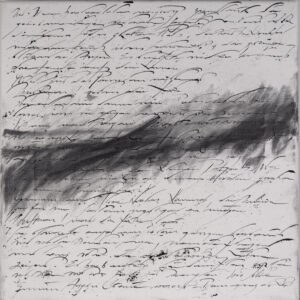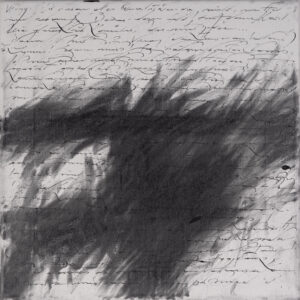Der irische Schriftsteller James Joyce (1882 – 1941) veröffentlichte am 2. Februar 1922 seinen mittlerweile zur Weltliteratur gehörenden Roman „Ulysses“ . In Anlehnung an Homers Erzählungen der Irrfahrten des Odysseus (7. / 8. Jahrhundert vor Chr.), schildert James Joyce einen einzigen Tag im Leben seines Protagonisten Leopold Bloom, den 16. Juni 1904. Er berichtet dabei nicht nur von dessen Erlebnisse während er durch die Straßen und Gassen Dublins geht, sondern lässt die Leser auch an den Gedankengängen der Protagonisten des Romans teilhaben.
Herwig Prammer nahm Textstellen aus dem Roman heraus und schrieb auf jeder der 10 Tafeln mit seiner Handschrift diese Worte. Über alle 10 Tafeln, die er im Atelier nebeneinander stehen hatte, zeichnete er mit Graphit eine durchgehende Szenerie einer Landschaft.
The Irish writer James Joyce (1882 – 1941) published his novel „Ulysses“ on 2 February 1922, which has since become part of world literature. Based on Homer’s tales of the voyages of Odysseus (7th/8th century B.C.), James Joyce describes a single day in the life of his protagonist Leopold Bloom, 16 June 1904, not only recounting his experiences as he walks through the streets and alleys of Dublin, but also allowing readers to share in the thought processes of the novel’s protagonists.
Herwig Prammer took passages from the novel and wrote these words on each of the 10 panels in his own handwriting. Over all 10 panels, which he had standing next to each other in his studio, he drew a continuous scene of a landscape with graphite.

ULYSSES #1 – #10, 2022, gesso, ink and graphite on canvas, 30 x 300 cm
Da James Joyce in der Zeit von etwa 1914 – 1922 an seinem epochalem Werk schrieb, lebte er nicht mehr nur in Dublin, sondern auch in Triest, Pola und in Zürich. Da die Handlung des Romans sich auf die Straßen von Dublin konzentriert, nahm PJ Maguire diesen Umstand auf und fragte einen befreundeten Künstler, durch eine Straße von Dublin zu gehen und die Umgebung, den „Sound“ der Stadt, aufzunehmen. Er verband die erste Tafel Herwig Prammers mit der Augmented Reality APP von Artivive.
As James Joyce was writing his epochal work between 1914 and 1922, he lived not only in Dublin, but also in Trieste, Pola and Zurich. As the plot of the novel focuses on the streets of Dublin, PJ Maguire took this fact and asked an artist friend to walk through a street of Dublin and record the „sound“ of the city and connected the first panels of Herwig Prammer’s work to it using Artivive’s Augmented Reality APP.

#1
animated by PJ Maguire with augmented reality technology of artivive
Please focus the artwork with the smartphone and the video will start.
The App is free of charge:
www.artivive.com
Wenn der Betrachter die APP direkt vor dem Kunstwerk verwendet und mit allen 10 Tafeln, die in einer Reihe hängen, vor Augen, wird AR nochmals zu einem besonderen Erlebnis:
When the viewer uses the APP directly in front of the artwork and with all 10 panels hanging in a row before their eyes, AR becomes a special experience once again:
Link zum Reel – Instagram ip.forum
Herwig Prammer: The texts on the canvases are various quotes from james joyce’s ulysses:
1. Mr Bloom prepares breakfast and muses about his cat
2. Mr. Bloom enters Burton’s restaurant and reflects on what he perceives
3. reference to Homer’s chapter on Kirke’s pigsty from the Odyssey.
Virag Lipoti from Szombathely appears in the eroticised scenery of the evening establishment. An inner surrealist dialogue unfolds.
Tafeln #2 – 10:

#2

#3

#4

#5

#6

#7

#8

#9

#10
homepage: www.prammer.com
Herwig Prammers work is part of the exhibition: The look of the Irish, March 1 – 31, 2022
